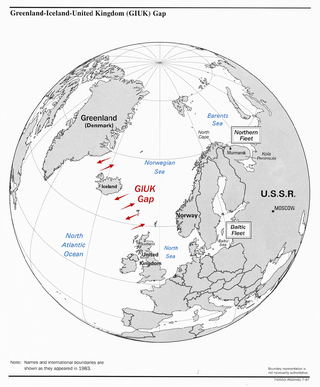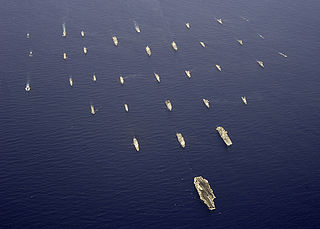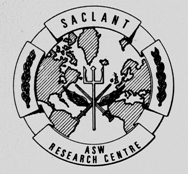Related Research Articles

The GIUK gap is an area in the northern Atlantic Ocean that forms a naval choke point. Its name is an acronym for Greenland, Iceland, and the United Kingdom, the gap being the two stretches of open ocean among these three landmasses. It separates the Norwegian Sea and the North Sea from the open Atlantic Ocean. The term is typically used in relation to military topics. The area has for some nations been considered strategically important since the beginning of the 20th century.

The Naval Undersea Warfare Center (NUWC) is the United States Navy's full-spectrum research, development, test and evaluation, engineering and fleet support center for submarines, autonomous underwater systems, and offensive and defensive weapons systems associated with undersea warfare. It is one of the corporate laboratories of the Naval Sea Systems Command. NUWC is headquartered in Newport, Rhode Island and has two major subordinate activities: Division Newport and Division Keyport in Keyport, Washington. NUWC also controls the Fox Island facility and Gould Island. It employs more than 4,400 civilian and military personnel, with budgets over $1 billion.

Underwater warfare, also known as undersea warfare or subsurface warfare, is naval warfare involving underwater vehicle or combat operations conducted underwater. It is one of the four operational areas of naval warfare, the others being surface warfare, aerial warfare, and information warfare. Underwater warfare includes:

The Republic of Singapore Navy (RSN) is the maritime service branch of the Singapore Armed Forces (SAF) responsible for defending the country against any seaborne threats and as a guarantor of its sea lines of communications. The RSN traces its origins to the Royal Navy when Singapore was still a crown colony of the British Empire. The service was formally established in 1967, two years after its independence from Malaysia in 1965, and had undergone a substantial modernisation ever since – which has led them into becoming the most powerful navy in Southeast Asia.

A blue-water navy is a maritime force capable of operating globally, essentially across the deep waters of open oceans. While definitions of what actually constitutes such a force vary, there is a requirement for the ability to exercise sea control at long range.

USNS Mizar (MA-48/T-AGOR-11/T-AK-272) was a vessel of the United States Navy. She was named after the star Mizar.

The Indian Ocean Rim Association (IORA), formerly known as the Indian Ocean Rim Initiative (IORI) and the Indian Ocean Rim Association for Regional Cooperation (IOR-ARC), is an international organisation consisting of 23 states bordering the Indian Ocean. The IORA is a regional forum, tripartite in nature, bringing together representatives of Government, Business and Academia, for promoting co-operation and closer interaction among them. It is based on the principles of for strengthening Economic Cooperation particularly on Trade Facilitation and Investment, Promotion as well as Social Development of the region. The Coordinating Secretariat of IORA is located at Ebene, Mauritius.

Unmanned underwater vehicles (UUV), sometimes known as underwater drones, are submersible vehicles that can operate underwater without a human occupant. These vehicles may be divided into two categories: remotely operated underwater vehicles (ROUVs) and autonomous underwater vehicles (AUVs). ROUVs are remotely controlled by a human operator. AUVs are automated and operate independently of direct human input.

A green-water navy is a maritime force that is capable of operating in its nation's littoral zones and has limited competency to operate in the surrounding marginal seas. It is a relatively new term, and has been created to better distinguish, and add nuance, between two long-standing descriptors: blue-water navy and brown-water navy.
The Indian Ocean Research Group Inc. (IORG) is an Indian Ocean Regional academic network. The key objective of IORG is to initiate a policy-oriented dialogue, in the true spirit of partnership, among governments, industries, NGOs and communities, towards realizing a shared, peaceful, stable and prosperous future for the Indian Ocean region. IORG is currently based at the University of Adelaide, and Curtin University, Australia, South Asian University, New Delhi and Panjab University, Chandigarh, but members come from all across the world.
Diver detection sonar (DDS) systems are sonar and acoustic location systems employed underwater for the detection of divers and submerged swimmer delivery vehicles (SDVs). The purpose of this type of sonar system is to provide detection, tracking and classification information on underwater threats that could endanger property and lives. Further, this information is useful only to the extent that it is made available to authorities in time to make possible the desired response to the threat, be it deterrent or defensive action. Subsurface threats are a difficult problem, because reliable detection is available to date chiefly by use of high-resolution active sonar or trained dolphins or sea lions. The threat of an underwater terrorist attack is a concern to the maritime industry and port law enforcement agencies. Ports face a range of threats from swimmers, boat-delivered ordnance such as limpet mines and other forms of improvised underwater explosive devices. DDS systems have been developed to provide underwater security for ports, coastal facilities, offshore installations, pipelines and ships. Due to the variety of life and objects that exist under the water, it is desirable that a DDS system be capable of distinguishing between large sea mammals, shoals of fish; a ship's wake; a diver with an open circuit scuba set and a stealth diver with a rebreather. DDS systems have been developed that can be mounted on the seabed, on a pier or on the hull of a vessel. For complete port security these systems are integrated with the surface surveillance and security systems employed at ports, coastal facilities and offshore installations. Various systems provide specialized features to facilitate their use in port security systems including automatic detection features.
The String of Pearls is a geopolitical hypothesis proposed by United States political researchers in 2004. The term refers to the network of Chinese military and commercial facilities and relationships along its sea lines of communication, which extend from the Chinese mainland to Port Sudan in the Horn of Africa. The sea lines run through several major maritime choke points such as the Strait of Mandeb, the Strait of Malacca, the Strait of Hormuz, and the Lombok Strait as well as other strategic maritime centres in Pakistan, Sri Lanka, Bangladesh, the Maldives, and Somalia.

The SACLANT ASW Research Centre was the predecessor to the NATO Undersea Research Centre. It was known as The SACLANT ASW Research Centre from 1959 through 1986, and the SACLANT Undersea Research Centre from 1987 through 2003. The centre was commonly referred to as SACLANTCEN.

Liberdade class blended wing bodies are autonomous underwater gliders developed by the US Navy Office of Naval Research which use a blended wing body hullform to achieve hydrodynamic efficiency. It is an experimental class whose models were originally intended to track quiet diesel electric submarines in littoral waters, move at 1–3 knots and remain on station for up to six months. The "Liberdade" was the name of a ship built by Joshua Slocum prior to the one he single-handedly piloted around the world.
Maritime domain awareness (MDA) is defined by the International Maritime Organization as the effective understanding of anything associated with the maritime domain that could impact the security, safety, economy, or environment. MDA is said to work as a ‘key enabler’ for other maritime security issues, such as anti-piracy patrols, in the way that in order to do effective patrols you need to have the ability of conducting effective MDA. The maritime domain is defined as all areas and things of, on, under, relating to, adjacent to, or bordering on a sea, ocean, or other navigable waterway, including all maritime-related activities, infrastructure, people, cargo, and vessels and other conveyances.
The Knifefish is an autonomous unmanned underwater vehicle (UUV) under development by General Dynamics Mission Systems and Bluefin Robotics for the United States Navy. It is a propeller-driven minesweeping robot designed to replace the Navy's trained dolphins and sea lions after the retirement of the 50-year-old Marine Mammal Program in 2017. The Knifefish was first unveiled at a Navy exposition in April 2012, and was originally intended to operate in concert with the Navy's littoral combat ships (LCS) as part of a specialized counter-mine system.
The Indian Ocean Naval Symposium (IONS) is a series of biennial meetings between the littoral states of the Indian Ocean region. It provides a forum to increase maritime security cooperation,discuss regional maritime issues, and promote friendly relationships among the member states.
SAGAR, used as a backronym or reverse acronym which stands for Security and Growth for All in the Region, is a label used by the Prime Minister and Government of India for India's vision and geopolitical framework of maritime cooperation in the Indian Ocean region. Sagar means 'ocean' or 'sea' in multiple Indian languages. Since the first usage of the phrase in 2015 at Port Louis by Prime Minister Narendra Modi the term has been adapted to include more elements such as linkages with the Indo-Pacific region.

The Information Management and Analysis Centre (IMAC) was approved in 2012 and operationalized in 2014. Located in Gurugram, it is the nodal agency for maritime data fusion that links information from the high seas and Indian's coastline and island territories.

The Information Fusion Centre – Indian Ocean Region (IFC-IOR) is a regional maritime security centre hosted by the Indian Navy. Launched in December 2018, the centre works towards enhancing maritime security and safety in the Indian Ocean. Currently, the IFC-IOR has International Liaison Officers (ILO) from 12 partner nations. It also has more than 65 international working-level linkages with nations and multi-national/ maritime security centres.
References
- 1 2 Das, Arnab; Bangara, Suresh (16 January 2019). "Underwater Domain Awareness and Acoustic Capacity Building – A Maritime Security Perspective in the Indian Ocean Region". bharatshakti.in. Retrieved 4 December 2019.
- ↑ Finch, David (Fall 2011). "Comprehensive Underwater Domain Awareness: A Concept Model" (PDF). Canadian Naval Review. 7 (1).
- ↑ National Plan to Achieve Maritime Domain Awareness for the National Strategy for Maritime Security (PDF) (Report). United States Federal Government. October 2005.
- ↑ Boraz, Steven C. (Summer 2009). "Maritime Domain Awareness - Myths and Realities". Naval War College Review. U.S. Naval War College Digital Commons. 62 (3).
- 1 2 3 Lt Donald B. Davis, USCG Guard Reserve, Port Clinton, Ohio “The Submersible Threat to Maritime Homeland Security” Master of Arts in Security Studies (Homeland Security and Defence), The Naval Postgraduate School, Sep 2013.
- ↑ Hwee-Pink Tan et al., “A Survey of Techniques and Challenges in Underwater Localization” Ocean Engineering, Volume 38, Issues 14–15, October 2011, Pages 1663-1676.
- ↑ Urick, R.J. (1983) Principles of Underwater Sound. 3rd Edition, McGraw-Hill, New York.
- ↑ Lt Cdr Peter M. Morisseau, USCG, "Coast Guard Maritime Security in the Underwater Domain", Acquisition Research Program Sponsored Report Series, Graduate School of Business & Public Policy, Naval Postgraduate School, Feb 2015
- 1 2 3 Das, Arnab (2016-07-02). "Impact of maritime security policies on the marine ecosystem". Maritime Affairs: Journal of the National Maritime Foundation of India. 12 (2): 89–98. doi:10.1080/09733159.2016.1246751. ISSN 0973-3159. S2CID 114407494.
- ↑ "Pelagos Cetacean Research Institute". Pelagos Cetacean Research Institute. Retrieved 2019-12-12.
- ↑ Frantzis, Alexandros; Leaper, Russell; Alexiadou, Paraskevi; Prospathopoulos, Aristides; Lekkas, Dimitrios (2019-02-27). Tsikliras, Athanassios C. (ed.). "Shipping routes through core habitat of endangered sperm whales along the Hellenic Trench, Greece: Can we reduce collision risks?". PLOS ONE. Public Library of Science (PLoS). 14 (2): e0212016. Bibcode:2019PLoSO..1412016F. doi: 10.1371/journal.pone.0212016 . ISSN 1932-6203. PMC 6392247 . PMID 30811429.
- 1 2 3 4 5 6 7 8 9 10 Das, Arnab (May 2017). "Indian Leadership must in the Indian Ocean Region". Focus. Geopolitics: 52.
- 1 2 Vasan, RS (2016-02-09). "India: International Fleet Review 2016". South Asia Analysis Group . Retrieved 2020-06-07– via Center for International Maritime Security.
- ↑ Das, Arnab (2020-01-15). "Underwater Domain Awareness: A New Perspective for Young India". Inter-Actions. Retrieved 2020-06-07.
- ↑ "Prelims Spotlight: SAGAR Programme (Security and Growth for All in the Region), Indian Medical Association, DigiShala". www.civilsdaily.com. 18 June 2018. Retrieved 2 December 2019.
- 1 2 Das, Arnab (3 April 2018). "Underwater Domain Awareness a New Paradigm in the Indian Ocean Region".
- ↑ Expert Brief by Alyssa Ayres, "The U.S. Indo-Pacific Strategy Needs More Indian Ocean", Council on Foreign Relations (cfr) for Asia program. Available at https://www.cfr.org/expert-brief/us-indo-pacific-strategy-needs-more-indian-ocean.
- ↑ Saran, Samir; Singh, Abhijit (3 May 2018). "India's struggle for the soul of the Indo-Pacific". www.lowyinstitute.org/the-interpreter. The Lowy Institute. Retrieved 6 December 2019.
- ↑ Ronald O'Rourke Specialist in Naval Affairs, “China Naval Modernization: Implications for U.S. Navy Capabilities—Background and Issues for Congress”, Congressional Research Service, August 1, 2018. Available at https://fas.org/sgp/crs/row/RL33153.pdf.
- ↑ Dr.(Cdr) Arnab Das, "China's 'Undersea Great Wall' Project: Implications, Dissecting the Threat and the Possibilities"
- 1 2 Das, Arnab (February 2017). "5". Marine Eco-Concern and its Impact on the Indian Maritime Strategy. MRC Press.
- ↑ Anthony H. Cordesman and Abdullah Toukan, The Indian Ocean Region: A Strategic Net Assessment, draft prepared for the Arab Center for Research and Policy Studies conference on Arab-U.S. Relations in Doha in June 2014
- 1 2 Das, Arnab; Varma, D.S.P. (24 June 2015). "Ocean Governance in the Indian Ocean Region – An Alternate Perspective". Maritime Affairs. National Maritime Foundation of India. 11 (1): 1–19.
- ↑ David Michel and Russell Sticklor, Indian Ocean Rising: Maritime Security and Policy Challenges, Stimson, Jul 2012. Available at http://www.stimson.org/images/uploads/research-pdfs/Book_IOR_2.pdf
- ↑ Shahid Amjad, "Seabed Resources", in Maritime Threats and Opportunities in the 21st Century, Conference Proceedings (Karachi: National Centre of Maritime Policy Research, Bahria University, 2007), pp. 42–45
- ↑ Arnab Das, "Marine Eco-concern and its Impact on the Indian Maritime Strategy", Journal of Defence Studies, Vol 8, No. 2, Apr 2014
- ↑ Paul C Etter, “Underwater Acoustic Modelling and Simulation”, Fourth Edition, CRC Press, 2013, Taylor and Francis Group
- ↑ "Acoustic Capacity Building in the Indian Ocean Region". Indian Defence Review. Retrieved 2020-04-24.
- ↑ Danio Joe, R V Shashank Shankar, R Vijayakumar and Arnab Das, “Concept Design of Autonomous Underwater Glider”, December, 2012 Vol 1 Issue 10 (Special Issue), International Journal of Innovative Research & Development.
- ↑ Arnab Das, “New Perspective for Oceanographic Studies in the Indian Ocean Region,” Journal of Defence Studies, Vol 8, No. 1, Jan 2014
- ↑ "China Captures a U.S. Navy Drone in the South China Sea". worldview.stratfor.com. 16 December 2016. Retrieved 5 December 2019.